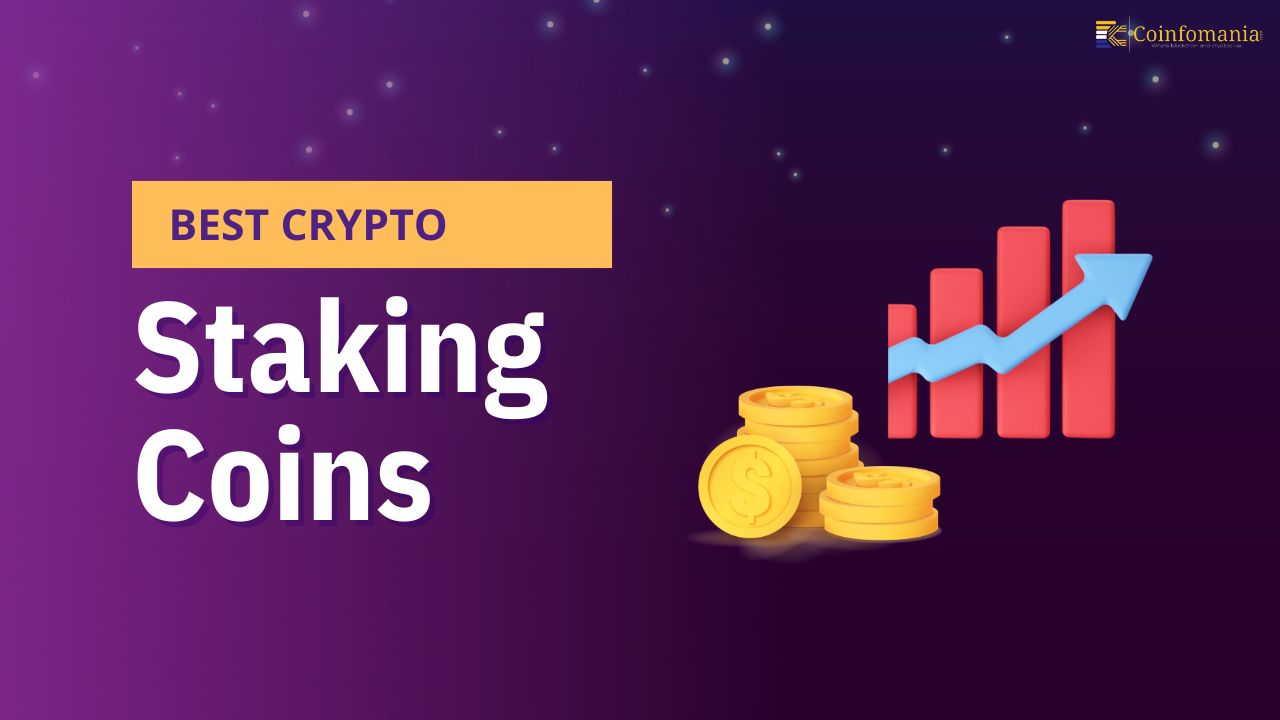Staking cryptocurrencies is an excellent way to earn passive income, which is why investors are always searching for the best crypto staking coins that promise the highest rewards. The concept behind staking involves locking your tokens on a blockchain network for a period of time to support its operation. This system ensures the security and transparency of the network.
Staking allows you to earn interest on your holdings, making it more profitable than simply leaving your assets idle in a wallet.
However, to maximize your staking returns, you need a coin that offers a higher APY and a favorable staking period. With so many options available, it’s important to know the best crypto coins to stake that offer the best returns.
To help you make the most of this opportunity, our team at Coinfomania has reviewed the best crypto staking coins that offer the highest rewards.
| Coin | Staking APY | Minimum Deposit | TVL Staked | Link |
|---|---|---|---|---|
| 4% | 32 ETH |
32.8M ETH | Stake ETH | |
| 12.99% | 1 BNB |
206.6K BNB | Stake BNB | |
| 3% | 5 ADA |
23.5B ADA | Stake ADA | |
| 6% | 0.01 SOL |
299.0M SOL | Stake SOL | |
| 8% | 25 AVAX |
215.2M AVAX | Stake AVAX | |
| 4% | 1 TRX |
43.3B TRX | Stake TRX | |
| 12% | 10 DOT |
824.9M DOT | Stake DOT | |
| 3% | 1 TON |
563.7M TON | Stake TON | |
| 20% | 1 MATIC |
3.7B MATIC | Stake MATIC | |
| 11% | 1 ICP |
– | Stake ICP | |
| 9% | 1 NEAR |
537.0M NEAR | Stake Near |
Best Crypto Staking Coins for Highest Rewards
Now that you’ve had a glimpse of the coins that we have picked, let’s evaluate each coin in detail –
 #1 Best Crypto Staking Coin
#1 Best Crypto Staking Coin

Ethereum (ETH)
- Staking APY: 4%
- Staking period: Few hours to 18 months
- Platform: Ethereum, Binance, Coinbase, Ledger, OKX, Kraken
- Volatility: High
Ethereum (ETH) is the second largest and most highly valued proof-of-stake coin, topping our list of the best crypto staking coins.
Ethereum switched from a Proof-of-Work (PoW) consensus to a Proof-of-Stake (PoS) consensus in September, 2022, in a process known as The Merge. The PoW consensus was energy-intensive and bad for the environment, whereas the PoS consensus cut the blockchain’s energy consumption by 99.99% and allows staking.
To participate in the validation process, you must stake a minimum of 32 ETH. The more ETH staked, the more reward they get. Moreover, when the pool of staked ETH increases, the annual interest rate decreases.
If you want to participate in the validation of blocks but cannot afford the minimum 32 ETH required, you can opt to join a staking pool. This way, you can combine your financial resources in order to participate in the validation process on the network.
Staked ETH cannot be used or withdrawn until the lock-up period is over, which can range from a few hours up to 18 months. Stakers can earn up to 4% of the annual percentage yield (APY) on the amount of ETH they stake, but this can vary depending on the platform you stake on.

Pros
- Offers full rewards to stakers directly from the protocol
- Stakers receive unburnt transaction fees for blocks they propose
- ETH is the most highly valued staking coin

Cons
- Malicious behavior results in penalties and forceful ejection from the network
- Staking fees apply when staking on centralized cryptocurrency exchanges and other staking protocols

Binance Coin (BNB)
- Staking APY: 12.99%
- Staking Period: 1-120 days
- Platform: Crypto exchanges and wallets.
- Volatility: High
Binance Coin (BNB) is the utility token on the Binance exchange, one of the world’s largest crypto exchanges by trading volume. It was officially launched on the Ethereum blockchain before moving to the BNB Smart Chain.
The BNB chain uses the Proof-of-Stake consensus mechanism and has over 40 validators, allowing users to stake Binance Coin. Validators are elected every 24 hours by delegators, another group that stakes their token to select validators that will secure the network.
BNB is used to pay for gas fees on the Binance Smart Chain as well as travel bookings, online services, entertainment, and financial services.
The minimum amount required for staking is 1 BNB. And depending on the platform, stakers can earn rewards of up to 12.99%.

Pros
- Being the native coin of the Binance exchange, BNB is quite high in demand
- Gas fees on the network are discounted, lowering the cost of high volume trading
- BNB staking is available on several platforms, including exchanges and wallets

Cons
- There is a huge number of stakers on the network, resulting in lesser rewards
- High rewards require long-term staking
- The BNB Chain has no inflation, leading to lower rewards compared to other blockchains

Solana (SOL)
- Staking APY: 3-6%
- Staking Period: 2-3 days
- Platform: Crypto exchanges, Mobile wallets
- Volatility: High
The Solana blockchain was launched to address the challenges of the Ethereum blockchain, like congestion, high gas fees, and slow transactions. And Solana’s native token, SOL, can be staked on the blockchain as it uses the Proof-of-Stake and Proof-of-History (PoH) consensus model.
The PoH model helps speed up transactions by generating timestamps for different transactions, allowing validators to simply agree on the order of transactions without having to wait for confirmations from others.
Solana contains 25 blocks, which are validated by 25 people at once. Stakers receive rewards in the form of newly minted SOL tokens depending on the amount they stake and the network’s inflation rate which reduces by 15% every year.
Solana staking is available in major crypto exchanges including Binance, Coinbase, Kraken, and mobile wallets like Trust Wallet and Phantom Wallet. Stakers can earn rewards up to 6% rewards depending on the platform they are using.

Pros
- Solana is quite popular in DeFi protocols and gaming projects
- Solana blockchain hosts decentralized applications
- Solana blockchain is faster and cheaper compared to others such as Ethereum and Cardano

Cons
- The Solana blockchain is susceptible to bugs, vulnerabilities, and downtime
- Solana is very volatile, and changes in price affect rewards

Cardano (ADA)
-
- Staking APY: 3%
-
- Staking Period: None
-
- Platform: Crypto exchanges and wallets
-
- Volatility: High
Cardano (ADA) is a cryptocurrency with one of the highest market capitalization. The Cardano blockchain was launched to address Ethereum’s scalability issues, and now, Cardano hosts several DeFi projects, including apps and games.
Cardano uses the Proof-of-Stake consensus mechanism, allowing investors to earn passive income with Cardano (ADA) by staking their tokens on the network. Stakers earn rewards of up to 3% on their staked ADA.
Stakers have two options for earning: operating a stake pool or pledging their tokens to an existing pool. Stake pools are trusted nodes that validate transactions. Operating a stake pool involves monitoring the node, renting servers, and performing other administrative duties.

Pros
- There is no lock-up period, allowing users to withdraw their staked tokens at any given time
- The Cardano blockchain is faster compared to other blockchains, such as Bitcoin and Ethereum
- Stakers have the freedom to choose a staking pool
- Available on major crypto exchanges, including Binance and Coinbase, that offer high rewards

Cons
- Low staking rewards on the Cardano network
- High inflation rate
- As a token, ADA has very little utility

Avalanche (AVAX)
- Staking APY: 4-8%
- Lock-in period: 14 days
- Platform: Crypto exchanges and wallets.
- Volatility: High
AVAX is the native token of the Avalanche blockchain, which is popular for its high speed and security. AVAX holders can stake their tokens on Avalanche to help secure the network and earn interest rewards. Stakers can earn rewards of up to 7.6% by staking as low as 25 AVAX, making it one of the best crypto staking coins.
Avalanche supports decentralized applications and side chains, including P-Chain, C-Chain, and X-Chain. And it is available to stake on major exchanges, such as Coinbase and Binance, and mobile wallets, like Ledger.

Pros
- There is no slashing of staked tokens as penalties in the Avalanche network
- Avalanche has the lowest hardware requirements compared to other blockchains
- The blockchain supports other DeFi projects like dApps

Pros
- Does not penalize malicious actors
- Only supports a limited number of nodes

Tron (TRX)
- Staking APY: 1-4%
- Staking period: 3 days
- Platform: Crypto exchanges and wallets
- Volatility: High
Tron (TRX) is the native token of the Tron blockchain. The network is designed to support the creation and deployment of smart contracts and decentralized applications. Justin Sun founded and launched it in 2017 to compete with the Ethereum platform.
Tron holders can earn passive income on their tokens through staking on the Tron network, crypto exchanges, or mobile wallets. Holders can stake as little as 1 TRX and earn rewards of up to 4%, depending on the platform they are staking on.
Tron (TRX) is available for staking on major crypto exchanges, including Binance, Kraken, Coinbase, and also wallets like Ledger, Trust Wallet, and Bit2Me, showing that it stands out as one of the top coins to conduct crypto staking on.

Pros
- Holders can stake as little as 1 TRX
- Punishes malicious actors through the slashing of staked tokens
- Tron network is faster and more cost-efficient compared to other blockchains like Ethereum
- The network is open-source, inviting developers to build on it

Cons
- Tron’s founder, Justin Sun, was involved in controversial activities that raised concerns about the credibility of the network
- Tron (TRX) faces regulatory uncertainties in various jurisdictions
- The Tron blockchain has been criticized for being too centralized, as more than half of the tokens in circulation are held in a few addresses

Polkadot (DOT)
- Staking APY: 12%
- Staking period: 1 year
- Platform: Crypto exchanges and wallets
- Volatility: High
The Polkadot blockchain, launched in 2020 by Ethereum co-founder Gavin Wood, connects different blockchains for secure data transfer without intermediaries. DOT is Polkadot’s native token, which holders can stake to earn rewards.
DOT holders can act as validators or nominators. Validators operate nodes, stake DOT, and verify transactions, earning tokens and reduced fees. Nominators delegate their DOT to trusted validators and receive a share of the earned rewards.
Polkadot has 1,000 validators and over 37,000 nominators. Stakers can earn up to 12% in rewards, depending on the platform and stake duration. The minimum amount to stake is 10 DOT for validators and 250 DOT for nominators.
DOT also acts as a governance token, allowing holders to vote on proposed upgrades. You can stake Dot on major crypto exchanges, including Binance, Coinbase, Kraken, Crypto.com, and ByBit, as well as wallets like Ledger, proving that it is among the best crypto coins for staking.

Pros
- Polkadot connects seamlessly with other blockchains, allowing cross-chain communication and easy data transfer
- Validators are penalized for downtime, mistakes and malicious activities
- Large community of members works together to help secure the network

Cons
-
- Long lock-up period of up to 365 days
-
- Validators risk losing their tokens if they make a mistake
-
- It is highly volatile

Toncoin (TON)
- Staking APY: 3%
- Staking period: 1 year
- Platform: Coinbase, Bybit
- Volatility: High
Toncoin (TON) is the native cryptocurrency of The Open Network (TON), a layer-1 blockchain designed by the team behind Telegram. TON was launched to provide fast, scalable solutions for DeFi projects such as dApps and smart contracts.
Toncoin holders can stake tokens to support the operations of the blockchain network. The blockchain uses the Proof-of-Stake consensus mechanism. To become a validator on the network, one can stake a minimum of 1 TON.
Stakers can get rewards of up to 3% on their stake, depending on the platform they are staking on. Currently, you can easily stake Toncoin on Coinbase and ByBit.

Pros
- Stakers can earn passive income while contributing to the network’s security
- TON allows cross-chain transfers to other networks like Ethereum
- It supports instant withdrawals

Cons
- Validators get fined for being idle or malicious.
- Staking on the TON network requires high-performance hardware
- Long lock-up period

Polygon (MATIC)
- Staking APY: 3-20%
- Staking period: None
- Platform: Crypto wallets
- Volatility: High
Polygon (MATIC) is the native token of the Polygon Network, a layer-2 sidechain scaling solution that runs alongside the Ethereum blockchain. It was launched in 2017 to allow speedy transactions at lower fees.
Polygon holders can stake their tokens and earn passive income while contributing to the network’s development. Investors can either participate in staking as validators or delegators.
You can stake as little as 1 MATIC on the Polygon network and earn as high as 20% interest on their stake, depending on the platform you stake on. Platforms that support Polygon staking include Polygon Wallet, MetaMask, and Ledger.

Pros
- Connected to the Ethereum blockchain
- Offers high staking rewards of up to 20%
- Have very strict policies for malicious actors

Cons
- MATIC is highly volatile in nature
- The network is prone to hacks and attacks that can result in the loss of tokens
- The network has limited space for accepting new validators

Internet Computer (ICP)
-
- Staking APY: 11%
-
- Staking period: 6 months
-
- Platform: Crypto exchanges and wallets
-
- Volatility: High
Internet Computer Protocol is an innovative blockchain that seeks to bring better speed, efficiency, and decentralization to computation and data storage. The blockchain, launched by the DFINITY foundation, allows developers to build online services, such as websites and applications, without relying on traditional information technology (IT) like web servers and cloud services. This makes online services run on ICP fully decentralized.
ICP is the native token of Internet Computer Protocol that is used to participate in governance and reward network participants. Stakeholders can participate in voting and earn passive income on the ICP network.
To become a stakeholder, users must lock up their tokens for a period of more than 6 months to 8 years. Staked tokens are held in neurons. Neurons contain information about how much is staked, for how long, and the amount of rewards it has accrued. Neurons that are locked for over 6 months gain the ability to submit proposals and vote on them.
Being one of the best crypto staking coins, the minimum amount required to stake ICP is 1 ICP token with up to 11% APY. However, this APY could vary, according to the lock-up period and platform staked on.

Pros
- Faster transaction processing speeds
- Staking on ICP requires long-term commitment, aligning investors’ interests with the growth and development of the ICP network
- Staking lock-up reduces selling pressure and helps stabilize the price of ICP

Cons
- Long lock up period
- Staking ICP requires technical knowledge

Near Protocol (NEAR)
- Staking APY: 9%
- Staking period: 1 day
- Platform: Crypto wallets
- Volatility: High
NEAR uses a new consensus mechanism called Nightshade, a modification of the Proof-of-Stake mechanism, which offers higher speeds and better security. It is the native token of the Near protocol that is used to pay for gas fees and staking.
You can stake as little as 1 NEAR and be able to participate in the development of the network while earning passive income. You can earn up to 9% interest on their staked tokens depending on the platform you use, making it one of the best crypto coins for staking.
Users can stake NEAR in crypto wallets such as the Near wallet, Trust Wallet and Ledger, as well as crypto exchanges like Kraken and Coinbase.

Pros
- The minimum staking amount is low, making it accessible to many investors.
- Validators are penalized and have their tokens slashed for malicious behavior.

Cons
- Staking on the NEAR protocol requires technical knowledge
How Does Crypto Staking Work?
Crypto staking involves locking up a certain amount of cryptocurrency to support the operations of a blockchain network. Investors can stake their crypto coins either through an exchange or directly via a crypto wallet. The network will use the staked coins to make new blocks on the blockchain. The more you stake, the higher your chances are of being selected to verify a transaction.
Staked coins are marked so they can be used to validate new tokens added to the blockchain. The tokens used in the validation process generate rewards in the form of interest to the owner. However, if an investor validates data incorrectly, they lose some of their staked crypto as a penalty.
However, staking locks up your crypto in a blockchain as a form of insurance for a certain period of time. This means you won’t be able to withdraw or trade your crypto even if prices shift.
Factors to Consider When Choosing Staking Coins
With a variety of staking coins available in the market, it can be difficult to choose right ones. Therefore, here we have compiled some factors you should consider when selecting the best crypto staking coins for you –
- Staking Rewards: The main motivation for staking cryptocurrency is earning rewards passively, without having to trade your crypto. Be sure to select a coin that offers high rewards consistently.
- Lock-up period and flexibility: Staked tokens are often locked up and cannot be withdrawn for a specific period of time. Lock-up periods can range from a few days to months. Some coins are flexible and allow you to unstake anytime, while others have stricter requirements. Investors should consider their need for liquidity before staking.
- Minimum Staking Requirements: Different networks have different staking requirements. Some require a substantial amount to become a validator while others require a minimum amount. It is important to consider how much you are willing to stake before choosing a coin.
- Coin value: It is advised to avoid coins with high inflation rate and volatility. High inflation might mean that even though you receive more tokens, their value might not increase proportionally.
- Coin Supply: Consider going for coins that have a fixed supply as this ensures healthy demand and price boost.
- Coin Utility: Select coins that have ample real-world utility such as digital payments. A coin with little to no utility is less likely to have demand therefore the price might be low.
Where to Stake Crypto Coins
With the growing popularity of staking, multiple platforms that support staking have emerged. Here are some of the platforms where you can stake tokens –
Crypto Exchanges
Crypto exchanges such as Binance and Coinbase provide users with a simplified user interface that allows them to stake tokens with just a few clicks. Crypto exchanges offer simplicity, security and a wide selection of cryptocurrencies to stake.
However, it is important to note that investors do not have custody of their assets in centralized crypto exchanges. Moreover, exchanges charge additional fees that reduce the overall staking rewards.
Crypto Wallets
Many cryptocurrency wallets such as Ledger, MetaMask and TrustWallet offer crypto staking services. Crypto wallets provide a balance of security and convenience by allowing users to stake directly from their wallets. Hardware wallets like Ledger add an extra layer of security.
The good thing about non-custodial wallets is that users have full control of their assets unlike in crypto exchanges.
Native Staking on Blockchain Network
Most PoS blockchains allow for native staking on the network e.g. Ethereum, Polkadot and Cardano. Native staking requires holders to operate validator nodes or join a validator pool. Native staking is however a bit technical and requires a certain level of expertise.
However, it offers more rewards as validators operate with discounted transaction fees.
DeFi Staking Platforms
DeFi staking platforms such as Lido provide non-custodial staking solutions for users to stake other tokens such as ETH. DeFi staking platforms usually have high rewards due to their low overhead costs.
However, smart contracts are more vulnerable to security risks compared to wallets and crypto exchanges.
FAQs
What is crypto staking?
Crypto staking is locking a potion of your tokens on a blockchain network in order to support its operations and earn rewards in return. Staking normally occurs on blockchains that use the Proof-of-Stake consensus mechanism.
How do I stake cryptocurrency?
Investors can stake cryptocurrency by becoming validators, or joining a staking pool. Validators operate nodes and verify transactions in exchange for lower transaction fees and a potion of the newly added tokens. Joining a staking pool involves entrusting your tokens to select validators who you trust to do things the right away and split the rewards with you.
What are the risks of staking crypto?
Staking cryptocurrency means you lock up your tokens for a specific period of time. This means you cannot easily withdraw or trade your tokens. Also, cryptocurrencies are volatile and rewards may fluctuate depending on the price of the token.
What are some of the best staking coins in 2024?
The best coins to stake in 2024 are Ethereum (ETH), Binance Coin (BNB), Solana (SOL) and Cardano (ADA). These coins have high crypto staking APY, flexible lock-up periods, and minimum staking requirements. Moreover, the tokens are highly valuable and have real-world utility.
What are some of the alternatives to staking coins for earning passive income?
Users who do not wish to stake can opt for Yield Farming to earn passive income with crypto. Yield Farming is lending tokens to DeFi protocols in order to provide them with liquidity and in exchange get rewards in the form of interest or fees. Yield farming is however complex and risky due to high volatility.
- Bitcoin Falls to $65K as Mt. Gox Transfers $2.8 Billion BTC to External Wallet
- News of Marathon Digital’s $138 Million Fine for Breach of Non-Disclosure Agreement Triggers a Bearish 2.5% of Its MARA Stock
- Are $530M Bitcoin ETF Inflows a Blessing or Caution?
- Metaplanet Teams with Hoseki for Real-Time Bitcoin Holdings Verification
- 10 Best Meme Coins To Invest in 2024
- Building Secure Blockchain Systems: An Exclusive Interview with ARPA and Bella Protocol CEO Felix Xu
- Building The “De-Facto Crypto Trading Terminal”: An Exclusive Interview with Aurox CEO Giorgi Khazaradze
- Building a New Global Financial System: An Exclusive Interview With Tyler Wallace, Analytics Head at TrustToken
- “Solana is the Promised Land for Blockchain” — An Exclusive Interview with Solend Founder Rooter
- El Salvador: Where The Bitcoin Revolution Begins With A Legal Tender

 Why Trust Us
Why Trust Us







